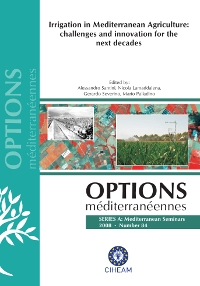| Article précédent | p. 311-315 | Article suivant |
Effects of electrical conductivity of irrigation water on the growth and production of Solanum lycopersicum L. var. cerasiforme grown in greenhouse
It was found that the negative effects of salinity on tomato become apparent with electrical conductivity values of the circulating solution starting from 2.5 - 3.0 dS m-1 for the fruits, from 4.5 - 5.0 dS m-1 for the stems and leaves and from 6.0 dS m-1 for the roots. The aim of the research was to study in tomato var. cerasiforme Naomi cultivated in greenhouse, the residual effects of irrigation carried out for 10 consecutive years with saline water. At 75 - 90 and 105 days after transplantation, five plants and corresponding soil samples from 0 to -40 cm, were collected from each plot. On each plant, the number and the weight of marketable fruits per cluster and the epigeal biomass dry weight were recorded. On each soil sample the electrical conductivity of extract saturated (ECe) was determined. The use of irrigation water with ECw fluctuating around 2.0 dS m-1 over a decade, determined values of ECe in the soil above the tolerance limit only for the fruit production (3.8 compared to 2.5 - 3.0 dS m-1). With ECw equal to 6.0 + 10.0 dS m-1, levels of ECe exceeded those considered detrimental to the production of dry epigeal biomass. The effects of increasing ECe on the fruit production were constantly determined through the reduction of fruit dry unit weight.
Les effets négatifs de la salinité sur la tomate commencent à partir d'une conductivité électrique de la solution circulante de 2.5 - 3.0 dS.m-1 pour les fruits, 4.5 - 5.0 dS.m-1 pour les tiges et les feuilles et 6.0 dS.m-1 pour les racines. L'objectif de cette expérimentation est d'étudier les effets résiduels de l'irrigation saumâtre pratiquée pendant dix ans sur la tomate var. cerasiforme Naomi cultivée sous serre. Aux jours 75, 90 et 105 après la transplantation, cinq plantes et cinq échantillons de sol correspondants, de 0 à 40 cm, ont été collectés sur chaque parcelle. Le nombre et le poids des fruits commercialisables par grappe ainsi que la biomasse en poids sec ont été enregistrés pour chaque échantillon de plante. La conductivité électrique de l'extrait de pâte saturé (ECe) de chaque échantillon de sol, a été déterminée. L'utilisation, sur dix ans, d'une eau d'irrigation ayant une ECw fluctuant autour de 2.0 dS m-1, a déterminé des valeurs de l'ECe du sol au-dessus de la limite de tolérance seulement pour la production de fruits (3.8 comparé à 2.5 - 3.0 dS.m-1). Avec des ECw de 6.0 + 10.0 dS m-1, les valeurs de l'ECe ont dépassé les limites de tolérance de la biomasse. Les effets de l'augmentation d'ECe sur la production des fruits ont été déterminés par la réduction du poids sec unitaire des fruits.
- [ Afficher ]
- [ Télécharger ]
- [ Exporter la citation ]
Vous pouvez télécharger la citation au format :
- [ Imprimer ]
-
Mots-clés
BIOMASSE, CONDUCTIVITE ELECTRIQUE, EAU D'IRRIGATION, EAU SALINE, SALINISATION DU SOL, TOLERANCE AU SEL, TOMATECiter cet article
Marchese M., Tuttobene R., Restuccia A., Longo A.M.G., Mauromicale G., Restuccia G. Effects of electrical conductivity of irrigation water on the growth and production of Solanum lycopersicum L. var. cerasiforme grown in greenhouse. In : Santini A. (ed.), Lamaddalena N. (ed.), Severino G. (ed.), Palladino M. (ed.). Irrigation in Mediterranean agriculture: challenges and innovation for the next decades. Bari : CIHEAM, 2008. p. 311-315. (Options Méditerranéennes : Série A. Séminaires Méditerranéens; n. 84). International Conference on Irrigation in Mediterranean Agriculture: Challenges and Innovation for the Next Decades, 2008/06/17-18, Naples (Italy). http://om.ciheam.org/om/pdf/a84/00800978.pdf



